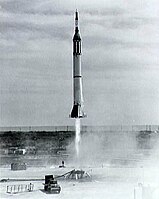Mercury-Redstone BD
| Mission dates | |||
|---|---|---|---|
| Mission: | Mercury-Redstone BD (MR-BD) | ||
| COSPAR-ID : | MERCRBD | ||
| Launcher: | Redstone Mercury , serial number MRLV-5 | ||
| Begin: | March 24, 1961, 17:30 UTC | ||
| Starting place: | LC-5 , Cape Canaveral | ||
| Landing: | March 24, 1961, 17:38 UTC | ||
| Landing place: | Atlantic | ||
| Flight duration: | 8min 23s | ||
| Earth orbits: | suborbital flight | ||
| Apogee : | 183 km | ||
| Covered track: | 494 km | ||
| Maximum speed: | 8245 km / h | ||
| Maximum acceleration: | 11 g | ||
| Start photo | |||
 Launch of MR-BD (NASA) |
|||
| ◄ Before / After ► | |||
|
|||
Mercury-Redstone Booster Development (MR-BD) was the last unmanned mission to test the Redstone rocket as part of the American Mercury program . A dummy capsule with a dummy rescue rocket was used.
Before a manned launch with a Redstone rocket, the aim was to solve the problems that had occurred with Mercury Redstone 2 .
The reason for the excessive acceleration on the previous flight was a defective valve that controlled the flow of hydrogen peroxide to the steam generator, causing the fuel pumps to run too fast. Therefore, on this and subsequent Mercury Redstone missions, the rocket was modified to address this issue. In addition, four reinforcements made the rocket less sensitive to vibrations. The capsule was not separated from the missile as intended. The team reached a maximum speed of approx. 8200 km / h and a summit height of approx. 180 km. It hit the Atlantic 494 km from the launch site and sank there.
As all the objectives set for the mission were achieved, the rocket was released for manned flights.
Web links
- NSSDC: Mercury Redstone BD
- NASA: MR-BD (15)
- NASA History Series: MR-BD is not MR-3. In: This New Ocean: A History of Project Mercury. (English)
